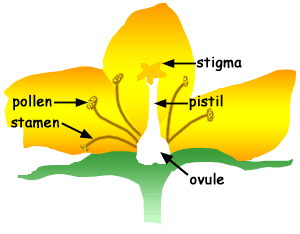Pollination is a very important process in flowers. It is the process by which pollens is transferred in the reproduction of plants, thereby enabling fertilization and reproduction.

Flowers have different parts. The male part is stamen that produces a sticky powder called pollen. The female part is called the pistil which has the sticky top called the stigma. Seeds are made in the ovule, at the base of pistil. Pollen must move from stamen to stigma to pollinate.
When pollen from a plant’s stamen is transferred to the stigma of the same plant it is called self-pollination. When the pollen from a plant’s stamen is transferred to the stigma of a different plant, it is called cross-reproduction.
An organism that moves pollen from one plant to another is called pollinator. Bees, butterflies, moths, hummingbirds, sunbirds, some wasps, some flies and fruit bats are good pollinators. When a pollinator is involved in pollination it is called biotic pollination is which very common among flowers. When the organism comes at the plant to get food it accidently rubs against stamens and get pollen stuck all over it. When it moves to another flower some the pollen can rub off onto the stigma of the new plant. Plants that are pollinated by this process are often bright and have a strong smell to attract the pollinators.
When pollination is mediated without the involvement of a pollinator, the process is called abiotic pollination. The most common form of abiotic pollination is pollination by wind. The wind picks up pollen from one plant and blows it onto another. This type of pollination is common in grasses, conifers and deciduous trees. Plants that are pollinated by wind of ten have long stamens and pistils. The flowers of these plants are dull in color and are unscented since they do not have to attract pollinators. They have small or no petal since pollinator does not need to land on it. Another media of abiotic pollination is water. The pollination by water is called Hydrophily and occurs in aquatic plants which release their pollen directly in the surrounding water.
Image sources: https://www.clker.com/clipart-14008.html
https://www.mbgnet.net/bioplants/images/pollparts.gif
SchoolTutoring Academy is the premier educational services company for K-12 and college students. We offer tutoring programs for students in K-12, AP classes, and college. To learn more about how we help parents and students in Brandon visit: Tutoring in Brandon.

